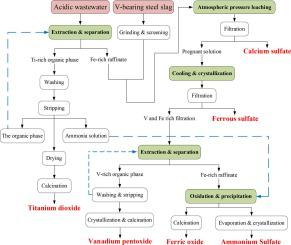Separation and Purification Technology ( IF 8.6 ) Pub Date : 2021-07-19 , DOI: 10.1016/j.seppur.2021.119335 Jinrong Ju 1, 2, 3 , Yali Feng 1 , Haoran Li 2, 3 , Shunliang Liu 1 , Chenglong Xu 1, 2, 3

|
Two typical wastes (acidic wastewater and vanadium-bearing steel slag) produced in the metallurgical process of vanadium-titanium magnetite not only pose a huge threat to the environment, but also waste a lot of resources such as V, Ti, and Fe. In order to effectively treat the two wastes and recover the resources such as V, Ti, Fe and Ca, a collaborative utilization process has been studied. When the O/A ratio of 1.5, the P204 concentration of 20% (v/v), the single-stage extraction rate of titanium was above 96%. After two-stage countercurrent extraction, the extraction rate of Ti can be reached 99.86%, while the co-extraction rate of Fe was less than 3%. The leaching rates of V, Fe, and Mg in the vanadium-bearing steel slag were respectively 98.68%, 99.67% and 99.63% under the condition of a ratio of the volume of the raffinate after titanium extraction to the mass of the vanadium-bearing steel slag at 8:1 (75 min at 60 °C). The analysis through XRD proves that the leaching conditions had an effect on the composition of the leaching slag, of which temperature had the greatest impact on it, and the composition of the leaching slag was anhydrite at 90 °C. After the leaching solution was pre-reduced with ammonium sulfite, the P507 extractant can separate V and Fe very well, and the V-loaded organic phase was treated by ammonium carbonate stripping and calcination process, the product of V2O5 with a purity of 99.03% can be obtained. Additionally, after the raffinate after vanadium extraction was oxidized with H2O2 solution and neutralized with ammonia solution, the solid product and solution obtained by filtration were respectively processed to obtain a roasted slag containing 72.14% Fe2O3 and a product of 99.09% purity of (NH4)2SO4.
中文翻译:

基于协同利用工艺的酸性废水和含钒钢渣中V、Ti、Fe、Ca的分离回收
钒钛磁铁矿冶炼过程中产生的两种典型废物(酸性废水和含钒钢渣)不仅对环境构成巨大威胁,而且浪费了大量的钒、钛、铁等资源。为了有效处理两种废物,回收钒、钛、铁、钙等资源,研究了协同利用工艺。当O/A比为1.5,P2O4浓度为20%(v/v)时,钛的单级提取率在96%以上。经过两段逆流萃取后,Ti的萃取率可达99.86%,而Fe的共萃取率小于3%。含钒钢渣中V、Fe、Mg的浸出率分别为98.68%、99.67%和99%。在提钛后萃余液的体积与含钒钢渣的质量比为8:1(60℃下75分钟)的条件下为63%。XRD分析表明,浸出条件对浸出渣的成分有影响,其中温度对其影响最大,90℃时浸出渣的成分为硬石膏。浸出液经亚硫酸铵预还原后,P507萃取剂能很好地分离钒和铁,负载钒的有机相经碳酸铵汽提和煅烧工艺处理,产物钒 其中温度对其影响最大,90℃时浸出渣的成分为硬石膏。浸出液经亚硫酸铵预还原后,P507萃取剂能很好地分离钒和铁,负载钒的有机相经碳酸铵汽提和煅烧工艺处理,产物钒 其中温度对其影响最大,90℃时浸出渣的成分为硬石膏。浸出液经亚硫酸铵预还原后,P507萃取剂能很好地分离钒和铁,负载钒的有机相经碳酸铵汽提和煅烧工艺处理,产物钒可以得到纯度为99.03%的2 O 5。另外,将提钒后的萃余液用H 2 O 2溶液氧化并用氨溶液中和后,分别对过滤得到的固体产物和溶液进行处理,得到含72.14% Fe 2 O 3的焙烧渣和产物99.09 (NH 4 ) 2 SO 4 的%纯度。



























 京公网安备 11010802027423号
京公网安备 11010802027423号